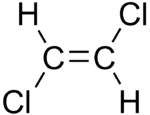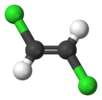1,2-Dichloroethene
| cis-1,2-Dichloroethene (Z) (left) and trans-1,2-Dichloroethene (E) (right) | |
|---|---|
 |
 |
 |
 |
| 1,2-Dichloroethene | |
| Other names 1,2-Dichloroethylene | |
| Identifiers | |
| CAS number | 156-59-2 (Z) |
| PubChem | 643833 (Z), 638186 (E), 10900 (mixture of E and Z) |
| ChemSpider | 10438 |
| KEGG | C06792 |
| ChEBI | CHEBI:18882 |
| Jmol-3D images | {{#if:Cl[C@H]=CClClC=CCl|Image 1 Image 2 |
| |
| |
| Properties | |
| Molecular formula | C2H2Cl2 |
| Molar mass | 96.95 g/mol |
| Density | Z: 1.28 g/cm³ E: 1.26 g/cm³ |
| Melting point | Z: -81.47 °C E: -49.44 °C |
| Boiling point | Z: 60.2 °C E: 48.5 °C |
| Dipole moment | Z: 1.9 D E: 0 D |
| Except where noted otherwise, data are given for materials in their standard state (at 25 °C (77 °F), 100 kPa) | |
| Infobox references | |
1,2-Dichloroethene, commonly called 1,2-dichloroethylene or 1,2-DCE, is an organochloride with the molecular formula C2H2Cl2. It is a highly flammable, colorless liquid with a sharp, harsh odor. It can exist as either of two geometric isomers, cis-1,2-dichloroethene or trans-1,2-dichloroethene, but is often used as a mixture of the two. They have modest solubility in water. These compounds have "scarcely any industrial applications,"[1] although they are fundamental given their simple stoichiometries.
Production
cis-DCE is obtainable by the controlled chlorination of acetylene:
- C2H2 + Cl2 → C2H2Cl2
Industrially both isomers arise as byproduct of the production of vinyl chloride, which is produced on a vast scale. Unlike vinyl chloride, the 1,2-dichloroethylene isomers do not polymerize.[1]
These compounds once were used as solvents, but other chlorocarbons such as dichloromethane are now used.
Safety
These compounds have "moderate oral toxicity to rats."[1]
See also
References
- ↑ 1.0 1.1 1.2 E.-L. Dreher, T. R. Torkelson, K. K. Beutel (2011). "Chlorethanes and Chloroethylenes". Ullmann's Encyclopedia of Industrial Chemistry. Weinheim: Wiley-VCH. doi:10.1002/14356007.o06_o01.